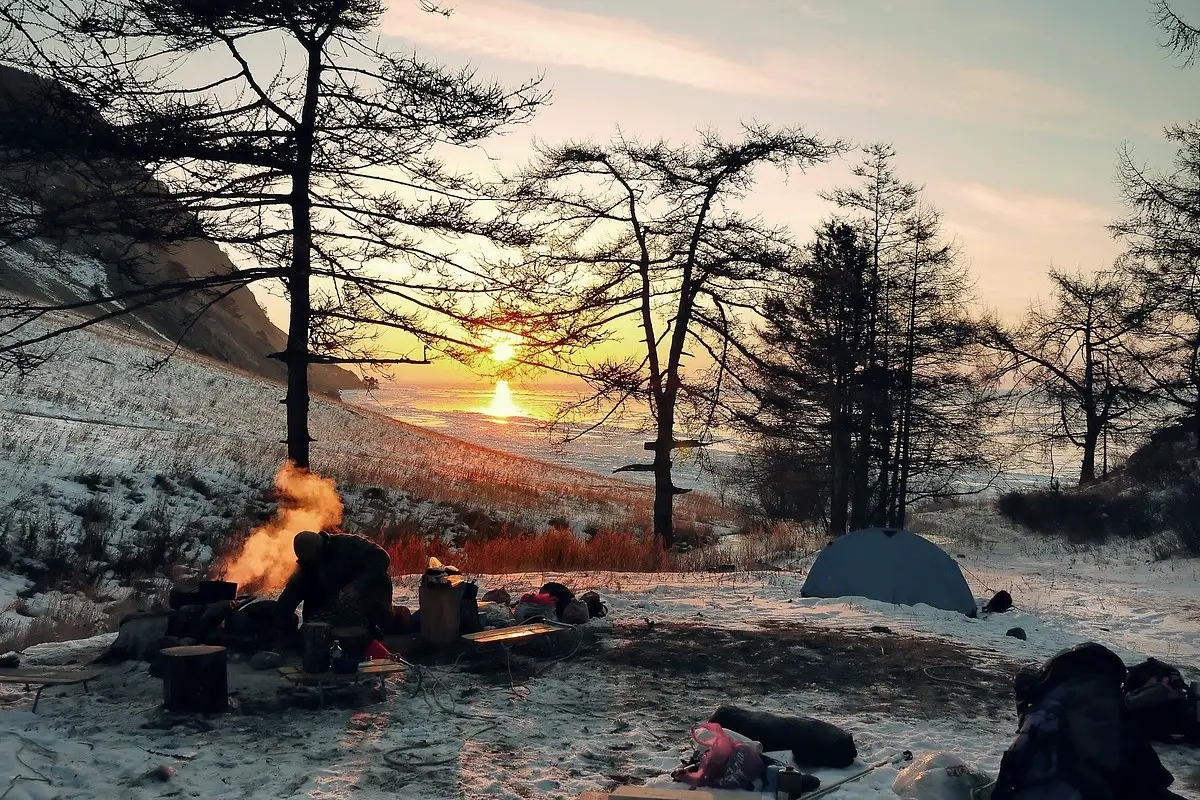Winter camping can be an exhilarating adventure, but staying warm is essential for a comfortable and safe experience. Whether you’re a seasoned camper or a beginner, mastering the art of staying warm in the winter wilderness is crucial. In this comprehensive guide, we will explore effective ways on how to stay warm while winter camping. From winter camping tips for staying warm to winter camping safety tips and essential winter camping gear for beginners tips, this article covers it all.
1. Dress in Layers: Your Ultimate Shield Against the Cold
Dressing in layers is the cornerstone of staying warm while winter camping. Start with a moisture-wicking base layer to keep sweat away from your skin. Add an insulating layer, such as fleece or down, to trap body heat, and top it off with a waterproof and windproof outer layer. This approach ensures you can adjust your clothing according to the weather, keeping you warm and dry throughout your winter camping adventure.
2. Invest in High-Quality Winter Camping Gear
Investing in high-quality winter camping gear tips is paramount. Look for insulated sleeping pads and sleeping bags designed for cold temperatures. A four-season tent, sturdy enough to withstand snow and wind, is essential. Additionally, pack portable heaters and hand warmers for extra warmth inside your tent.
3. Master the Art of Campsite Insulation
Proper insulation is key to staying warm in winter. Lay down a thick insulating layer under your tent, such as pine boughs or foam pads, to prevent the cold ground from drawing away body heat. Use rugs and blankets inside the tent to further insulate against the cold. Creating this barrier between you and the ground significantly enhances your warmth and comfort.
4. Hot Meals and Drinks: Your Winter Camping Allies
Enjoying hot meals and drinks can make a world of difference in staying warm. Pack a portable stove and prepare warm, hearty meals that provide sustenance and warmth. Hot beverages like tea, coffee, or cocoa not only warm you up but also keep your spirits high. Invest in a reliable thermos to keep your drinks hot during outdoor activities.
5. Stay Active: Generate Body Heat Naturally
Physical activity generates body heat, so keep moving to stay warm. Engage in light exercises or activities to maintain your body temperature. However, be mindful not to overexert yourself, as excessive sweating can lead to dampness and chills. Balance staying active with conserving energy to stay warm without risking exhaustion.
6. Master the Art of Layering in Sleeping Arrangements
Layering isn’t just for clothing; it’s a technique that can be applied to your sleeping arrangements too. Utilize a combination of sleeping bag liners, thermal blankets, and insulated clothing to create layers of warmth within your sleeping bag. This method traps heat close to your body, providing a cozy cocoon of warmth for a restful night’s sleep.
7. Winter Camping Safety: Know Your Limits and Be Prepared
Your safety should always be the top priority. Familiarize yourself with winter camping safety tips, such as recognizing signs of hypothermia and frostbite, and learn how to treat them. Carry an emergency kit containing essentials like hand warmers, a first aid kit, and a whistle. Inform a trusted person about your camping plans, including your destination and return time, ensuring help can reach you if needed.
8. Winter Camping Gear List for Beginners
Winter camping offers a unique and exhilarating outdoor experience, but it requires careful planning and the right affordable winter camping gear to stay warm and safe in cold conditions. If you’re a beginner looking to embark on a winter camping adventure, here’s a comprehensive gear list to help you prepare for the chilly wilderness:
1. Clothing:
- Moisture-Wicking Base Layers: Long-sleeve shirts and pants made of moisture-wicking material to keep sweat away from your skin.
- Insulating Layers: Fleece or down jackets, vests, and pants to trap body heat.
- Waterproof and Windproof Outer Layers: Jacket and pants with Gore-Tex or similar technology to protect against snow and wind.
- Insulated Gloves and Mittens: Waterproof and insulated to keep your hands warm and dry.
- Warm Hat: A beanie or balaclava to cover your head and ears.
- Thermal Socks: Several pairs of thick, moisture-wicking socks to keep your feet warm and dry.
- Waterproof Boots: Insulated and waterproof boots with good traction for snowy and wet conditions.
- Gaiters: To keep snow out of your boots and pants.
2. Shelter and Sleeping Gear:
- Four-Season Tent: A sturdy, windproof, and snow-resistant tent designed for winter camping.
- Insulated Sleeping Pad: To provide insulation from the cold ground.
- Cold-Weather Sleeping Bag: Rated for temperatures lower than what you expect to encounter.
- Sleeping Bag Liner: Adds extra warmth to your sleeping bag.
- Camp Stove: Lightweight and portable stove for cooking warm meals and drinks.
- Cookware: Lightweight pots, pans, and utensils suitable for winter cooking.
- Thermos: To keep hot drinks and soups warm throughout the day.
3. Safety and Navigation:
- Map and Compass/GPS: For navigation in case of snow-covered trails or low visibility.
- Headlamp: With extra batteries, as winter days are shorter.
- Multi-Tool or Knife: For various tasks around the campsite.
- First Aid Kit: Including supplies for treating frostbite, hypothermia, and other winter-related injuries.
- Emergency Whistle: To signal for help if needed.
- Firestarter: Waterproof matches, lighters, or fire starters to build a fire for warmth and cooking.
4. Extras:
- Hand and Toe Warmers: Disposable warmers to keep extremities warm.
- Snowshoes or Skis: Depending on the terrain, snowshoes or skis can help you navigate deep snow.
- Trekking Poles: Provide stability and support, especially in slippery conditions.
- Camera: Capture the beautiful winter landscapes and memories of your trip.
- Personal Items: Toothbrush, toothpaste, biodegradable soap, and other personal hygiene items.
5. Food and Water:
- High-Energy Snacks: Trail mix, energy bars, and dried fruits to keep your energy up.
- Water Bottles: Insulated bottles to prevent water from freezing.
- Water Purification: Filter or purifying tablets to ensure a safe drinking source if melting snow or using water from natural sources.
Conclusion
Mastering the art of staying warm while winter camping involves a combination of appropriate clothing, high-quality gear, and practical techniques. By following these 15 ways on how to stay warm while winter camping, you can confidently venture into the winter wilderness. Embrace the beauty of the snowy landscapes while staying warm and comfortable, ensuring a memorable and enjoyable winter camping experience. Happy camping!
Read More
RV Camping for Digital Nomads: Remote Work and Adventure on Wheels
RV Campground Reviews for Unique Experiences: Uncovering Hidden Gems
Pet Friendly RV Campgrounds and Destinations in the US
24 Hour Beaches Near Me, Ultimate Guide
Best RV Travel Destinations in USA for National Parks
Camping Gear That Will Make Your Life Easier: A Comprehensive Guide to Must-Have Camping Gadgets

